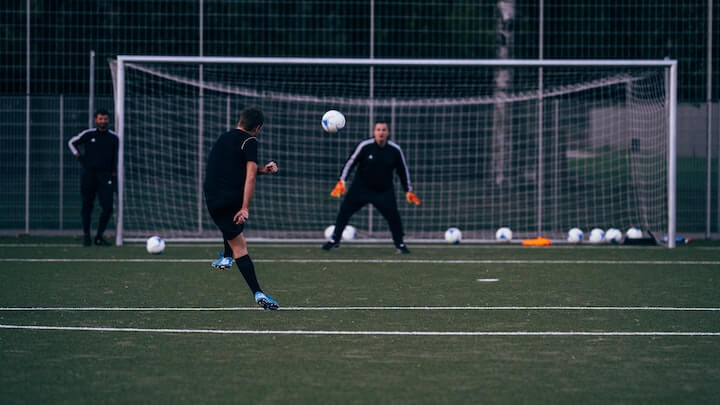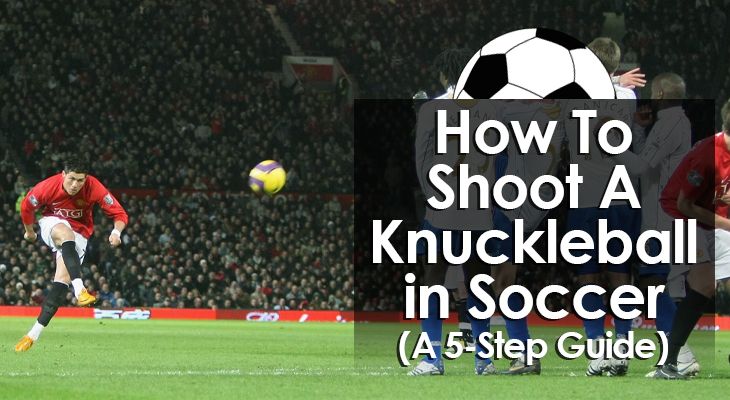How To Shoot A Knuckleball in Soccer (5-Step Guide)
The mastery of the knuckleball technique should be easier if one reviews the way that different soccer players execute it, such as Cristiano Ronaldo.
In this guide, we take a look at the history of the knuckleball technique as well as a 5-step guide to help you master the technique.
For further learning, we’ve also provided a shortlist of soccer players that use the technique.
You can watch them play and try to emulate their approach until you find what works best for you.
Let’s get into it!
What is the Knuckleball Technique?
A knuckleball is basically shooting the ball with little or no spin.
If executed properly, this causes the ball to move and dip in the air, in a similar manner to the shape of your knuckles when you clench your fists.
In soccer, players often try to score by using the element of surprise against the goalkeeper. Depending on the situation, players can achieve this in different ways.
For instance, an Olimpico goal is almost always scored when the goalkeeper is not prepared for or expecting it. The player usually tries to catch them off their line, or simply uses the direction of the wind to their advantage.
The rationale behind using the knuckleball technique is the same.
When in a situation where one would naturally be expected to take a powerful shot or go for a curling shot into the top corner, playing a knuckleball can catch the goalkeeper off-guard and increase the chances of a goal.
This is because the flight of the ball played with the technique is very hard to predict.
With a curler, one can watch the spin of the ball and follow its expected trajectory more easily.
However, the fact that a knuckleball has no spin means that the ball can literally move in the air at any point in another direction before it reaches its target.
As far as creating the element of surprise goes, it doesn’t get much better than that!
How To Shoot A Knuckleball in Soccer
First off, it's highly recommended to use a solid official match ball to practice.
These balls provide more consistent results therefore you’re more likely to replicate the technique in a real game situation.
Follow the five-step guide detailed below to learn how to shoot a knuckleball in soccer.
Step #1: The Run-Up
At this stage, you have more freedom over your approach than in the latter stages of executing the technique.
However, the recommended best practice is to take about 4 to 6 steps away from the ball, and 1 step slightly to the left or the right-hand side, depending on which foot you want to shoot with.
During the run-up itself, you can take a pointer from Cristiano Ronaldo’s approach by running up to the ball slightly on your toes.
This prepares you for connecting the ball with the right part of your foot.
Step #2: The Supporting Foot
Your supporting foot should be about 15 to 20 cm to the side of the ball at the time that your kicking foot is about to make contact with it.
Step #3: Point of Contact
To get the least amount of spin possible on the ball, try and hit it just below the center.
Cristiano used to face the valve of the soccer ball to himself to gauge where the center would be more accurately. This can help you too, but it is not compulsory.
Also, your foot contact point should be between the instep and the middle of your ankle joint.
Be sure to lock your ankle and make it stiff before making contact to avoid injury.
Step #4: Body Posture
If you lean back, you’re most likely to get more flight on the ball than you want.
So, make sure your posture is straight and leaning ever so slightly forward as you make contact.
Doing so gives you better control over the height that you get on the shot.
Step #5: The Follow-Through
The follow-through is crucial to the trajectory and success of your knuckleball kick.
After striking the ball, move your body in the direction of the shot to transfer the momentum from your body to the ball.
However, make sure that you stop the kicking leg from traveling forward with the ball more than 15 to 20 cm.
Then, try to settle your body in one or two steps.
Extra Tips
As you train with the five-step guide, there are a few extra tips to note:
(1) Practice your run-up without a ball
(2) In the beginning, focus on hitting the ball without spin before focusing more on power
(3) Always keep your body compact
(4) If you're not getting enough power on your shot, try turning your foot out slightly
(5) Practice daily.
(6) When you begin to get the hang of it, increase the difficulty levels by adding extra steps, scenarios, or challenges.
(7) Do not expect immediate results -- you will likely take a lot of bad shots; there is a steep learning curve to mastering a complex skill such as this one so be patient.

History of the Knuckleball in Soccer
The earliest recorded instance of using a knuckleball-like technique is traceable back to the 1950s, when Brazilian soccer player Didi was still very much in his prime.
However, the modern version of the technique became popular around 2006, when Adidas changed the method of how they make their balls.
They started using fewer panels on the balls, and also added more aerodynamic surface dimples. This changed the way that Adidas balls moved in the air when kicked a certain way.
At the time, free-kick expert, Juninho Pernambucano, was the first famous pro to use the technique regularly in the Ligue 1 to good effect.
Modern Examples of Famous Knuckleball Goals
The skill didn't really gather momentum until Ronaldo’s knuckleball goal against Portsmouth.
He completely dazzled David James and left him rooted to the spot.
At the 2010 World Cup, the controversial official match ball (called the Jabulani) was infamously known for its wild movements in the air. As a result, it was a prime candidate for more soccer players to try and execute the knuckleball technique.
The next World Cup in 2014 saw the use of a different ball (the Brazuca), but David Luiz managed to score a stunning knuckleball free-kick with it against Colombia.
More instances like that followed, and more players refined their technique to take advantage of the knuckleball -- mostly using it for long-range shots and free-kicks.
Five Knuckleball Experts
Here are five players that have scored spectacular goals with the knuckleball technique and who attempt it fairly regularly include:
1. Cristiano Ronaldo
Popularly seen as the godfather of the knuckleball technique in modern soccer.
Ronaldo’s goal against Portsmouth is one of his most famous executions of the skill.
He has also scored knuckleball free-kicks against other teams such as Atletico Madrid, Arsenal, and Denmark in the Euro 2012 competition.
2. David Luiz
David Luiz’s doesn’t attempt or score them as often as Ronaldo does - he is a defender, after all - but the importance of that goal against Colombia should not be understated.
3. Hakan Calhanoglu
Hakan is one of modern soccer’s most efficient dead-ball experts, and he has often tried knuckleball shots during live soccer matches.
His most famous attempt (and goal) is this stunning free-kick from 41 meters out in Hamburg’s win against Borussia Dortmund in the Bundesliga.
4. Gareth Bale
Gareth Bale has never been one to shy away from trying the outrageous, no matter how big the stage is.
In fact, his knuckleball goals are not the most outrageous options from his collection, but they’re up there.
5. Hulk
Hulk is known for being one of the most powerful attackers in global soccer, on and off the ball.
So, it is probably fitting that he has also been known to use the knuckleball technique to good effect.
Of the players on this list, he probably gets the most power on his shots. Take a look at this collection and have your pick of the bunch.
Final Words
The knuckleball technique is a very useful weapon to have in your arsenal as a soccer player, especially if you’re an attacker.
Soccer games are often decided by moments of individual brilliance, and there aren't many better expressions of that than a knuckleball goal scored at a time when your team is in desperate need of creating something from nothing.
However, it's important to master the technique as well as possible with a lot of work on the training ground before taking it to the field of play.
If you follow the 5-step guide discussed here very closely, you’ll be well on your way to becoming a knuckleball expert!

